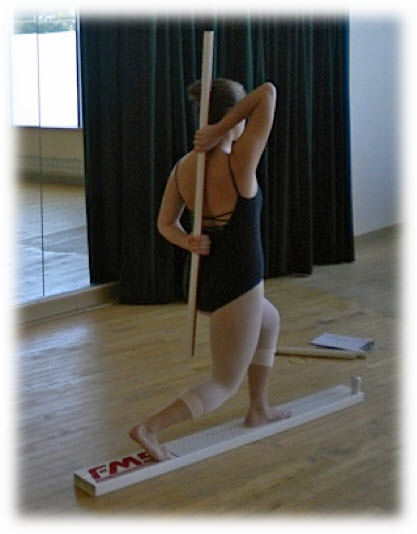Cross Training for Dancers: Constructing an Individualized Program for Balancing Exertion and Recuperation, Exercise/Fitness and Restoration Practices
 In professional sports, athletes may spend as much time in cross training models as they do on the practice fields. Dancers are artists, yet the rigor of physical training also requires training as an athlete. Cross training in sports and dance can improve performance, reduce injury, and provide greater longevity of participation.
In professional sports, athletes may spend as much time in cross training models as they do on the practice fields. Dancers are artists, yet the rigor of physical training also requires training as an athlete. Cross training in sports and dance can improve performance, reduce injury, and provide greater longevity of participation.
As discussed in Honoring Individual Differences in Human Anatomy and Physiology in Dance Training we each have a unique skeletomuscular structure. As such there are some innate talents and assets we bring to the art form of movement expression. It is important to honor and maximize our assets as we address, improve, or accommodate to challenges in technical training. Functional Awareness®: Anatomy in Action is a practice for working both in the dance training space and outside the studio. FA® teaches a sequence to release unnecessary tension, recruit for efficient muscle action, to restore the body towards balance. This path can be different for each individual.
If we have these differences how do we decide the best fitness and whole health strategy for our body?
There are several key elements to body wellness and developing strategies to encourage maximum potential for both mobility and stability in the body.
- Release unnecessary tension; learn somatic approaches. Cross training is not just about progressive overload. Many times unnecessary tension is a factor limiting progress in training. Sensory awareness practices develop skills to enhance body awareness, inner listening and embodied mindfulness. I am a passionate advocate for somatic practice work. It changed my life both physically and emotionally. I was in chronic back pain for most of my professional performing career in NYC. Massage and chiropractors were temporarily very helpful, but the pain returned. Somatic practice work changed my approach to training in profound ways and allowed exploration into new ways of moving and being in order to move out of pain and discomfort towards balance and stronger dance technique. I have studied Bartenieff Fundamentals, Feldenkrais Method®, Body/Mind Centering, Authentic Movement, Dance Therapy and for over 30 years, I have been certified to teach and practice the Alexander Technique. Somatic skills are the reason I can dance, perform, and teach today. Read this article by internationally recognized physical therapist/Alexander Technique teacher/Dance Science writer extraordinaire Glenna Batson for an introduction into somatic practices. https://www.iadms.org/general/custom.asp?page=248
- Recruit for efficient action; learn fitness strategies. Learn about current fitness components that can be addressed to maintain a healthy body for dance. Here is an excellent link for an introduction on fitness strategies to recruit for efficient action. https://www.iadms.org/?303
- Collect quantitative data on your body health and fitness. Use the technology available to enhance an understanding of individual movement function abilities, to listen to the body and move towards whole health. Physical Therapy assessments tools for fitness can be a good starting point. At Towson University we use the DanceFit Program designed by Andrea Lasner and the Johns Hopkins Medicine team to assess dance majors annually through their four years and provide quantitative measurements using a combination of FMS system assessments and measurements for functional and active turnout. If you do not have access to these tools or you prefer to receive more regular data on your fitness, individualized data collecting gadgets such as Fitbit or Misfit can help define starting points and track progress. Remember to be kind and gentle with yourself in reference to this information. It is one measure on one day. It is not telling the whole story of how your body works. It is providing some information for you to collect, think about, and consider within the whole picture of your training and instruction from your teachers and trainers.
- Attain an anatomical framework to understand your body. Learn a basic understanding of how the body functions to help provide a frame work or scaffolding in which to build a safe and effective health and conditioning model. Once source for anatomical information is Dance Anatomy by Jacqui Greene Haas. Also, look for Functional Awareness: Anatomy in Action: A Practical Guide to the Body by Romita and Romita to be released by Oxford University Press in 2016.
- Improvise, explore, and play. As artists we know the value of exploration and play to discover and invent movement and generate creative ideas. Todd Hargrove in his book A Guide to Better Movement suggests these skills develop a healthier neurological and neuromuscular system for whole health. For dancers this can mean more tools to improve technique and greater expressivity in movement.
Restore Towards Balance: A unique combination of all of these strategies help to create a balance between exertion and recuperation, recruitment and restoration.
Nancy Romita, MFA, MAmSAT, RSME
Senior Lecturer Towson University

Comments
Cross Training for Dancers: Constructing an Individualized Program for Balancing Exertion and Recuperation, Exercise/Fitness and Restoration Practices — No Comments
HTML tags allowed in your comment: <a href="" title=""> <abbr title=""> <acronym title=""> <b> <blockquote cite=""> <cite> <code> <del datetime=""> <em> <i> <q cite=""> <s> <strike> <strong>